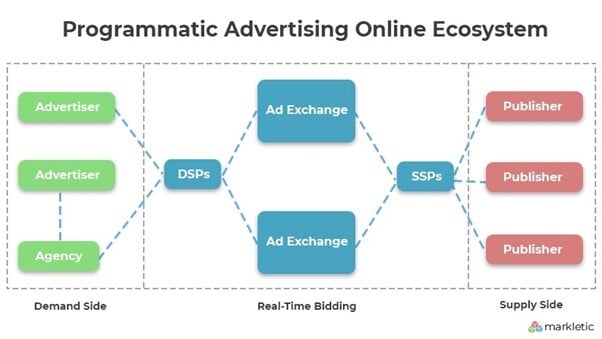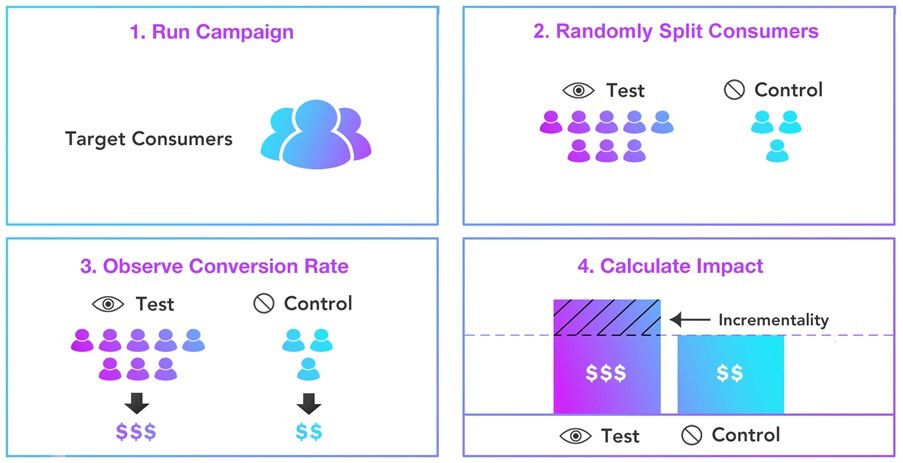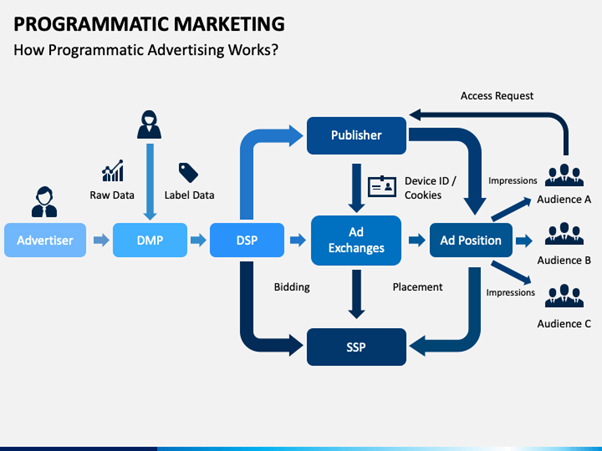Programmatic advertising is revolutionizing the way businesses market themselves. With B2B programmatic advertising, businesses can automate their advertising campaigns and target clients more effectively, resulting in higher ROI.
The global programmatic advertising market was valued at $451.3 billion in 2021 and is expected to increase at a CAGR of 35.8% from 2022 to 2031, reaching $9473.3 billion by 2031.

This blog post will discuss the benefits of B2B programmatic advertising and how businesses can leverage this technology to improve their marketing strategies. Read on to learn more about the advantages of programmatic advertising and how you can get started.
Introduction to B2B Programmatic Advertising
B2B Programmatic advertising is an automated approach to buying and selling digital advertising space, allowing for more efficient use of time and resources than traditional methods. B2B programmatic advertising is the same approach, but with a focus on the B2B market. This type of advertising is becoming increasingly popular, as it allows B2B businesses to target their audiences more effectively while providing greater transparency and control over their campaigns.
Additionally, programmatic advertising allows B2B businesses to define their target audience and customize their campaigns to reach them more efficiently. By using data-driven insights, B2B programmatic ad networks can help businesses maximize their return on investment in digital advertising.
What it is, and how it works?
B2B Programmatic advertising is an automated way of buying and selling advertising space in real-time. It eliminates the need for manual processes and instead utilizes automated algorithmic decision-making to purchase digital advertising space across an array of websites. This allows marketers to quickly reach their target audiences while ensuring that the ads are being shown to the right people. With programmatic advertising, marketers can also track the success of their campaigns in real time and make adjustments if needed. By using programmatic advertising, B2B marketers can maximize their exposure and reach their desired audiences more quickly and effectively.

What are the benefits of B2B Programmatic Advertising in marketing campaigns?
B2B programmatic advertising is a powerful tool for marketing campaigns. By leveraging data and automated systems, for B2B lead generation marketers can identify the right audience and target them with the right message, at the right time. The process could either be account-based marketing or content marketing with syndication this approach allows marketers to be more efficient and cost-effective with their ad spend, resulting in higher ROI.
Additionally, programmatic advertising grants marketers more control, allowing them to customize campaigns to fit the needs of their clients. Finally, the targeting capabilities of programmatic advertising enable marketers to generate highly-relevant and personalized advertisements, which can lead to higher engagement and conversion rates. As a result, B2B programmatic advertising is an invaluable tool for SEO-focused marketing campaigns.
Targeting precision
When it comes to B2B programmatic advertising, precision targeting with a multi-channel approach is essential to ensure that the right message is delivered to the right audience. This requires comprehensive keyword research, as well as research into the interests and demographics of the target audience, to ensure that content resonates with its intended recipients.

Additionally, localized search engine optimization (SEO) techniques should be used to ensure that the content is optimized for the English (US) language. This includes proper grammar, syntax, and semantics, as well as utilizing the right keywords and phrases to ensure that the content appears in the right search engine results pages. By taking these steps, businesses can ensure that their B2B programmatic advertising campaigns are successful.
Cost efficiency
Cost efficiency is an important factor to consider when it comes to B2B programmatic advertising. With the ability to target specific audiences, B2B programmatic advertising can save marketers a lot of money by only targeting those most likely to engage with their product or service. Additionally, the use of automated bidding algorithms can help to optimize campaigns for maximum efficiency. As a result, companies can save a significant amount of money by implementing a B2B programmatic advertising strategy, which is why SEO-focused blog posts should include a discussion of the cost savings associated with this type of advertising.
Improved ad performance
By improving ad performance in B2B programmatic advertising, businesses can gain a competitive edge in the market. Utilizing an SEO-focused blog post can provide businesses with the tools they need to maximize their ROI. The blog post should focus on topics such as keyword research, ad targeting, and content optimization.
Additionally, utilizing analytics tools to track performance and analyze data can help businesses better understand their target audience and tailor their campaigns accordingly. By utilizing these techniques, businesses can better identify their target audience and create content that resonates with them. This will help businesses improve their ad performance, drive more conversions, and ultimately increase their profits.
Increased transparency
Increased transparency in SEO-focused blog posts about B2B programmatic advertising can be achieved by providing accurate and up-to-date information about the latest trends and developments in the industry. This includes providing research and data on the effectiveness of programmatic advertising campaigns, as well as providing detailed explanations of how the different types of programmatic advertising work.
Additionally, the information should be presented in an easy-to-understand format and should be written in plain English, so that readers can easily comprehend the content. Lastly, readers should be provided with links to additional resources and information that they can use to further their understanding of the topic. By following these steps, the blog post can be an effective way to increase transparency and help readers make informed decisions about their B2B programmatic advertising efforts.
Best Practices for designing effective B2B programmatic ads campaigns
When creating a B2B programmatic ad campaign, there are a few best practices to consider to ensure your campaign reaches its full potential. First, it is important to consider audience segmentation and target the right groups. Targeting the right people with the right message is key to a successful campaign.
Second, create multiple versions of your ad to test for different audiences. This will help you determine which version resonates the most with your audience. Third, take advantage of location-based targeting to reach out to local clients.

Lastly, use A/B testing to analyze performance and optimize accordingly. By following these best practices, you can create a successful programmatic ad campaign that takes advantage of SEO and reaches the right people.
Defining Campaign Objectives
When creating a B2B programmatic advertising campaign, it is essential to take into consideration the best practices for designing an effective campaign. These best practices include segmenting your audience, creating multiple versions of your ad, using location-based targeting, and using A/B testing.
By following these best practices, you can maximize your SEO efforts and ensure your B2B programmatic advertising campaign is successful. By segmenting your audience, creating multiple versions of your ad, using location-based targeting, and using A/B testing, you can ensure your campaign is reaching the right people and delivering the right message.
By using DMP businesses must conduct research and invest in a robust data management platform (DMP). A data management platform (DMP) is an integrated digital tool or a machine learning platform that enables firms to collect, manage, and analyze data for business intelligence (BI). DMPs will collect data from first-, second-, and third-party sources, both online and offline. By leveraging DMP you can make necessary optimizations, create reports, and lookalike audiences.
A demand-side platform (DSP) on the other hand is a programmatic advertising platform that allows marketers to buy and manage ad inventory from numerous ad providers and advertisement spaces. The key advantage is that you can manage all of your digital ads across several networks from a single interface.
Identifying Target Audiences
Once the target audience for the blog post has been identified, it is important to ensure that the content of the post is tailored to the interests of that audience. It is also important to make sure that the post is written in a manner that is easy to understand and engaging. In this case, the content should be written in English (US) and should be optimized for search engine optimization (SEO). Keywords and phrases that are relevant to the topic of B2B programmatic advertising should be used in the post, along with relevant links to other websites that provide more in-depth information. Additionally, the post should feature images and infographics that help to illustrate the points being made. Finally, the post should be written in a conversational tone that is accessible and inviting to the target audience.
Crafting Compelling Ad Creative
When it comes to programmatic B2B advertising, crafting effective ad creative is essential. Your ad creative should be designed to attract the attention of your target audience and stand out among the competition. It should also be optimized for SEO, including incorporating relevant keywords and phrases and leveraging the power of visuals. Additionally, be sure to use language that resonates with your target audience. By combining compelling visuals, SEO optimization, and effective messaging, you can maximize your programmatic B2B ad campaign and reach your desired outcomes.
Hyper-segmentation based on intent data allows B2B programmatic advertising campaigns to be tailored to the specific needs of any given customer. By leveraging machine learning, marketers can quickly identify the best content, keywords, and creativity to serve each user. This allows for more effective campaigns that are better targeted, more personalized, and have a higher return on investment.
Selecting Ad Formats
When it comes to selecting ad formats for a B2B programmatic advertising campaign, it is important to decide the type of content you are advertising. For example, if the content is more visual, then banner or video ads may be the best choice. If the content is more informational, then text or native ads may be the best choice. Ultimately, the best ad format to select depends on the type of content you are promoting, the user profiles used, and the goals of the campaign. Additionally, it is important to consider the user experience when selecting ad formats, as this can have a significant impact on the success of the campaign.
Choosing Targeting Options
When it comes to targeting options for B2B programmatic advertising, you have a wide range of options to choose from. You can target audiences based on their demographics, interests, behaviors, and more. You can also target specific devices, geographic locations, and even the time of day. You need to experiment and tailor your campaigns to reach the most relevant and engaged audiences.
Additionally, you can use real-time bidding to maximize the impact of your campaigns. This allows you to bid for each impression on an online advertising exchange, ensuring you’re reaching the right people at the right time. Ultimately, understanding your audience and utilizing the right targeting options can help you get the most out of your B2B programmatic advertising campaigns.
Measure the effectiveness of campaigns
To measure the effectiveness of programmatic ad campaigns, marketers should look at incremental uplift metrics, such as cost-per-action (CPA) and return on ad spend (ROAS). Marketers must perform experiments to determine the success of their campaign and any areas that may need improvement.
Additionally, marketers should be sure to regularly monitor the performance of their campaigns to ensure the best possible results. By taking the time to review the performance of their campaigns, marketers can spot changes enabling development in performance quickly and adjust their targeting options accordingly.
Optimizing Campaign Performance
Once the campaign is launched, it is important to monitor its performance of the campaign regularly. This can be done by tracking the impressions, clicks, conversions, and other metrics associated with the campaign. By keeping a close eye on the performance of the campaign, adjustments can be made quickly to optimize the programmatic advertising campaign’s performance. Additionally, this will help to ensure that the budget is being spent most effectively and that the programmatic ad is reaching the right audience.
Conclusion
By leveraging the power of programmatic advertising, you can increase your ROI and generate more business for your company. Additionally, by creating multiple versions of your ad, you can determine which version resonates the most with your audience. Also, location-based targeting allows you to reach out to local clients. Finally, by using A/B testing, you can analyze performance and optimize accordingly.
S2W Media's programmatic advertising capabilities are an invaluable asset to B2B businesses looking to maximize their reach. With the ability to target specific demographics and geographic areas, S2W Media offers a complete guide that ensures that your advertising messages are reaching the right audiences. Additionally, S2W Media's retargeting capabilities enable you to follow up on potential clients who have previously shown interest in your products or services. This way, you can stay top of mind and convert leads into actual sales. With the ability to manage large campaigns and its multi-channel approach, S2W Media can help you create the most effective programmatic advertising strategy for your business.
_MI-Jul-21-2025-12-05-32-3762-PM.png?width=1600&height=1000&name=642c8576cb588fb37a11f85f_MicrosoftTeams-image%20(137)_MI-Jul-21-2025-12-05-32-3762-PM.png)


